Notice: Undefined variable: page in /home/vrxdg1855sn3/public_html/wp-content/themes/72tree/content.php on line 15
Notice: Trying to get property 'ID' of non-object in /home/vrxdg1855sn3/public_html/wp-content/themes/72tree/content.php on line 15
Can We Live Without Trees and How to Save Them

Without trees, we all die. Besides providing oxygen for us to breathe, trees make life on earth sustainable. Discover what is happening to the world’s trees and why we urgently need to stop senseless deforestation.
Trees affect everything from the air we breathe to the rain that falls from the sky. Without a robust population of trees, we die and so does our planet.
72tree.com gathered tree information, statistics, problems, and actions we can all take to preserve our trees and our habitable planet.
What Will Happen if We Cut Down All the Trees?
Right now, just over 3 trillion trees are growing on our planet. Every year, over 15 billion of those trees are felled or lost to natural disasters. At this rate, earth’s last tree will fall in roughly 200 years.
As earth’s tree population nears zero, the following will occur:
Oxygen and CO2 – Trees remove CO2 from the atmosphere and convert it to oxygen through the process of photosynthesis. Without them converting CO2 to oxygen, CO2 levels would begin to rise while oxygen levels would steadily fall.
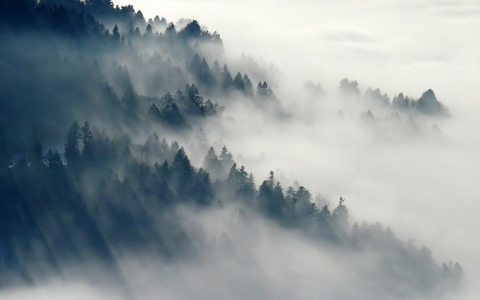
Trees are responsible for 35% of the oxygen we breathe. The other 65% are produced by algae and phytoplankton in the oceans.
Flooding and Erosion – Without tree roots to absorb water and stabilize the soil, even the smallest of storms will result in significant flooding, topsoil erosion, and landslides.
Air and Soil Pollutants – Trees work nonstop to filter ammonia, sulfur dioxide, nitrogen dioxide, and carbon monoxide from the air and soil.
Without trees, these pollutants would find their way into what crops are left and into the feed of what animals are left, not to mention the air we breathe.
Evapotranspiration – Without trees, the process of evapotranspiration would stop. This is the process of moistening the air which produces more clouds. Evapotranspiration is responsible for maintaining the delicate balance between fertile land and dry desolate desert.
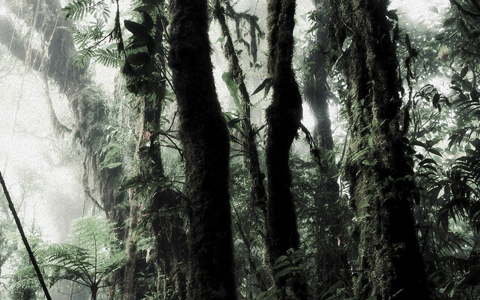
Fewer clouds mean less rain. With less rainfall, fertile land would dry up, fresh water sources would run out or stagnate, and agriculture will begin to fail on a global scale.
Acid Rain – Without trees to remove pollutants, what little rainfall remains would be mostly acidic. All remaining plant life would be crippled.
Global Warming – As the earth’s temperatures rise, the polar ice-caps would melt at an accelerated rate, causing ocean levels to rise and inundate coastal lands and freshwater sources.
As witnessed primarily in the south pole, the ice caps are already receding at an alarming pace, and if this melting isn’t slowed or stopped, it could threaten the survival of all wildlife within that ecosystem.
As the ice melts and causes desalinization in the oceans, weather patterns are subject to erratic change. Off-season snow storms, tsunamis, typhoons, hurricanes, and even blistering summers can all be driven by our raising global thermostat.

Labored Breathing – With CO2 levels on the rise and oxygen levels depleted, people with respiratory and blood problems would be the first to die along with animals unable to cope with the atmospheric changes.
Extinction – Small animals which once depended on trees for food and shelter would be the first to perish. Within a short period, the natural food chain would begin to lose its structure, leaving carnivorous scavengers to likely last the longest.
As temperatures continue to rise, the oxygen levels in the atmosphere decrease, and food sources become even more scarce, the food chain – in its entirety – would eventually break down, leaving every living creature on the planet on a collision coarse with extinction. Including mankind.
The timeline and events portrayed above are a representation of the first fifty to one hundred years without trees.
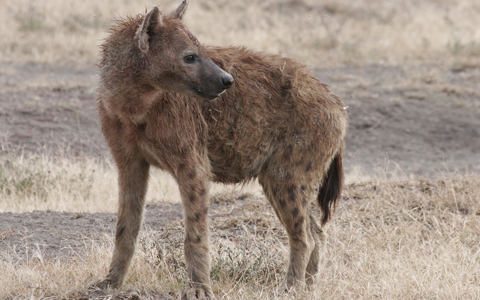
What Can We Do to Stop Deforestation?
You alone can make a tremendous impact on the future of our planet’s tree population. The following are ways that you can help stop deforestation:
Plant a Tree – Every tree you plant slows down the effects of deforestation. However, planting a tree isn’t enough. It is just as important to keep that tree healthy and resistant to disease and insect infestation.
Adding to the complexity of this situation is the process of natural deforestation. This is when beetles and other boring insects successfully attack large numbers of trees in either urban settings or forests. As these trees die, they dry out and become fuel for wildfires.
Besides annual inspections of your trees, whenever you detect the presence of an infestation or disease, call an arborist to assess the situation and offer a course of action.
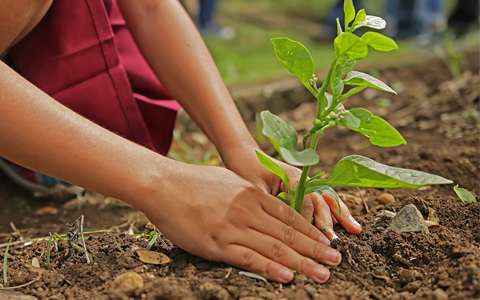
you can discover more about tree health problems and solutions by visiting 72tree.com/9-common-tree-health-problems-solutions/
Go Paperless – Whenever possible, receive and pay bills online. With the technological advances we have at our fingertips, we are able to reduce the use of nearly all paper products drastically.
Recycle – For decades, companies and households of all sizes have been recycling. You can push this concept forward by only purchasing recycled paper products and by recycling yourself.
Look for Forest Stewardship Council Certification – This is known as FSC certification and can be found on wood, paper, and food products. Products with this certification are produced in sustainable ways and can be classified as follows:
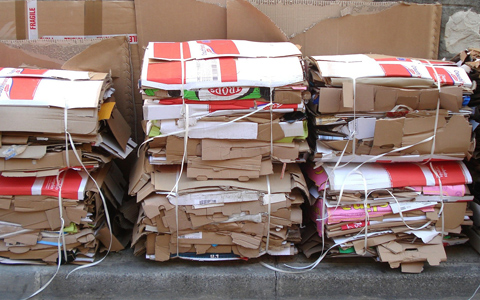
• FSC 100% includes products that come from FSC-certified forests.
• FSC Recycled means the wood or paper within a product is sourced from reclaimed material.
• FSC Mixed means at least 70 percent of the wood in a product comes from FSC-certified or recycled material, and that 30 percent is made of controlled wood.
Eat Vegetarian – By eating vegetarian or vegan meals as often as possible, you are reducing the demand for livestock, thereby reducing the need for deforestation to graze the animals.
Teach Others about Sustainability – The most impactful thing you can do to save our trees and forests is to teach others how to live sustainably.
According to recent research, nearly half of the world’s trees have been lost over the past 12,000 years to agriculture and population growth, and at the rate trees are currently being cut down, they will be gone in 200 years unless we take action to prevent it.
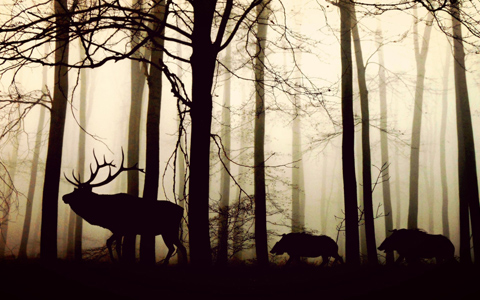
What Can We Do to Save Trees
As mentioned above, planting a tree helps turn back the effects of deforestation, while saving trees is a bit different. To save a tree, you don’t necessarily need to travel to the forest and stand in the way of a bulldozer.
You can save trees every day by caring for the ones that surround you:
• Plant trees in their hardiness zone.
• Plant trees in locations where they can grow freely.
• Adjust soil conditions to match your trees’ needs.
• Prune your trees as it grows.
• Water your trees during dry weather.
• Learn to identify signs of disease and infestation.
• Schedule annual inspections by an arborist.
• When a tree becomes a hazard, have it removed.
That last bullet point may have confused you. There are times when tree diseases or infestations can pose a grave threat to the surrounding ecosystem. In such cases, removing the tree may be the only practical option to protect other trees.
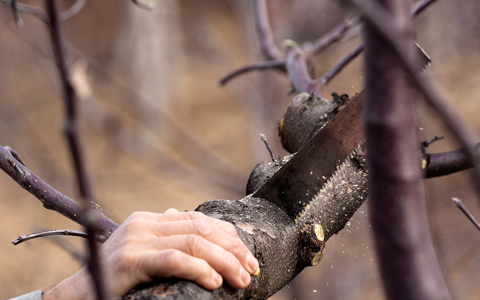
Cutting Down Trees Affects Us and Our Environment
All living creatures including mankind need trees to breathe, eat, and live. Life on earth, at all levels, depends on the abundant existence of a healthy tree population.
In this article, you discovered important tree population information, statistics, problems, and actions we can take to care for our trees and keep our planet habitable.
Ignoring that there is a problem only allows the problem to flourish. If we are to preserve our planet, each of us must take action in some way to keep our trees healthy and rely less on the material possessions that encourage deforestation.
Sources:
https://blogs.worldbank.org/opendata/five-forest-figures-international-day-forests
https://www.epa.gov
https://www.greenpeace.org/usa/forests/solutions-to-deforestation/
https://www.ucsusa.org/global-warming/solutions/stop-deforestation
https://ic.fsc.org/en/what-is-fsc-certification
https://www.nature.com/articles/nature14967
Notice: Undefined variable: page in /home/vrxdg1855sn3/public_html/wp-content/themes/72tree/content.php on line 15
Notice: Trying to get property 'ID' of non-object in /home/vrxdg1855sn3/public_html/wp-content/themes/72tree/content.php on line 15
Tulip Tree Information, Problems, and Care
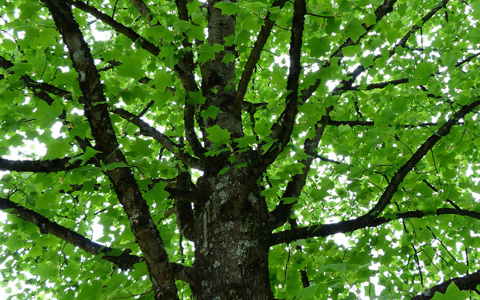
Liriodendron tulipifera also known as tulip poplar is neither tulip nor poplar. This species is a relative of the magnolia tree and is unbelievably easy to care for.
A native North American species, L. tulipifera is the state tree of multiple states, unique in its rapid rate of growth, and exceptional in its beauty. The tulip tree should be strongly considered for mid-sized and large landscapes.
72tree.com gathered tulip tree information, problems, care tips, and answers several frequently asked questions.
Tulip Tree Information
Liriodendron tulipifera is a blooming tree species native to eastern North America. The tulip tree is among the tallest of the eastern US species, is long-lived, and a favorite specimen tree in landscaping.
Tree Name – Yellow poplar
Scientific Name/Species – Liriodendron tulipifera
Family – Magnoliaceae
Genus – Liriodendron
Nickname(s) – Tulip tree, tulipwood, American tulip tree, tulip tree, tulip poplar, whitewood, and Oonseentia (in the native Miami-Illinois language).
State Tree – Indiana, Kentucky, and Tennessee.
Lifespan – Can live up to 500 years or more when planted in optimal conditions.
Type – Deciduous.
Hardiness Zone(s) – from 4 to 9
Soil Requirements – Prefers well-drained, slightly acidic, moist, rich, and fertile soil with full sun exposure.
Planting Spacing – 35ft between trees.
Watering Requirements – Regular when young or planted. Minimal thereafter.
Height – 80 to 100ft on average (can reach nearly 200ft under optimal conditions)
DBH – 4 to 6ft.
Crown Span – 30ft or more at maturity (can be conical or oval in shape).
Root Spread – Yellow poplar roots will tend to match the growth of the tree. If the tree is 100ft tall by 40ft wide, its roots will likely grow 100ft deep and 40ft wide. In some cases, the roots may extend much farther outward in search of water.
Uses in Landscaping – A magnificent specimen, screen, or large shade tree, and is better suited for more spacious landscapes.
Winter/Fall Colors – Yellow before leaf-drop in the fall.
Tulip Tree Problems
Healthy tulip trees are incredibly resistant to insect infestations and disease. However, when your tree is stressed by drought conditions, soil compaction, soil nutrient depletion, or poor pruning, insects and diseases can successfully attack it.
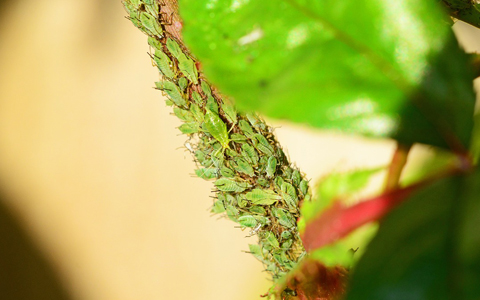
Pests – Tuliptree scale, yellow poplar weevil, and aphids, in the spring and summer months.
Disease – Powdery mildew, verticillium wilt, and canker.
Major Disease Threat – Verticillium Wilt
Symptoms of Verticillium wilt are premature foliar chlorosis and necrosis, and discoloration in both stems and roots. Symptoms of wilting become more apparent on warm or hot days.
This pathogen attacks a potential host by colonizing its roots and spreading throughout the roots, trunks, and stems. Due to this, one of the best forms of disease management is to encourage the healthy growth of your tree.
Tulip Tree Care Tips
There isn’t much you will need to worry about as long as your tulip tree is:
• Within its hardiness zone (4-9).
• Growing in partial shade to full sun.
• Planted in moist, well-drained soil with a pH of 3.7 to 6.5.
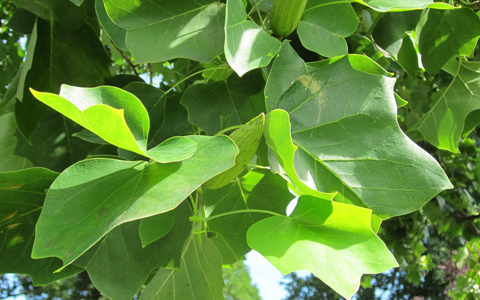
Pruning should be done once the tree has entered dormancy in late fall and early winter. However, when cankers are detected, prune out the affected area including the canker (all the way to the trunk if needed).
If the canker is located on the trunk, or when other irregularities are detected, call on a professional tree service or arborist to evaluate the tree and offer guidance.
People Also Ask
Question: Are tulip tree roots invasive?
Answer: No. If they are planted far from structures, walkways, or driveways, and the roots are readily able to absorb moisture.
Answer: Yes. As with all tree species, the purpose of roots is a never-ending quest for water and nutrients. When they are deprived, they will spread, and make their way underneath foundations and other structures.
For more on the destructive capabilities of tree roots, read 72tree.com/tree-roots-buckling-concrete-driveway/
Question: What is tulip poplar wood used for?
Answer: Lumber from tulip poplars is commonly used for fencing, siding, flooring, and some furniture.
Question: Can poplar wood be painted?
Answer: As this wood has a particularly straight grain, paints adhere to it quite well. Stains, on the other hand, have a tendency to blotch and usually require that a conditioner be applied before application.
Question: Is poplar as strong as oak?
Answer: No. While considered to be a hardwood, the fast growth rate of the tree produces a softer/weaker wood making it easy to work with.
Question: Do tulip trees bloom every year?
Answer: Yes. However, this species only produces its first blooms after nearly 20 years of growth. Thereafter, it will bloom annually in late spring or early summer.
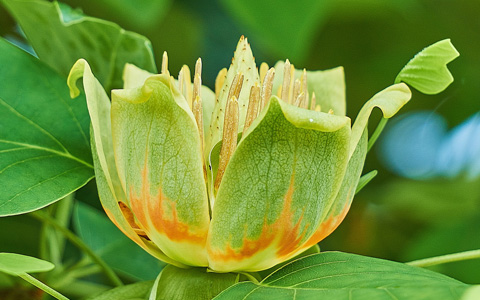
Question: Are tulip trees messy?
Answer: Yes. Like all deciduous tree species, they lose their foliage in the fall. If subjected to drought conditions, tulip trees may drop their foliage prematurely in late summer. Not to mention that when the tree blooms, the flower petals will litter the ground around the tree.
Question: Can tulip trees be planted in Georgia?
Answer: Yes. The entire state is within the required hardiness zone for healthy tulip tree growth. For more on this and other great landscape trees, read 72tree.com/5-popular-alpharetta-ga-shade-trees/
Liriodendron Tulipifera is a Perfect Landscape Specimen
Although sometimes called “tulip” or “poplar,” or both, the Liriodendron tulipifera is neither of the two. This magnificent relative of the magnolia rapidly grows tall and full, making it highly desirable as a landscape specimen tree.
In this article, you discovered tulip tree information and specifications, its problems, how to care for them, and answers to frequently asked questions.
If the tulip tree isn’t a part of your landscape, you are missing out on a fast growing and beautifully shaped shade or screen tree. They are easy to plant and require minimal care efforts.
Sources:
https://extensiongardener.ces.ncsu.edu/extgardener-tulip-poplars-for-large-and-small-landscapes/
http://ipm.ucanr.edu/PMG/GARDEN/PLANTS/tuliptree.html
https://extension.psu.edu/tulip-poplar-diseases
http://www.apsnet.org/edcenter/intropp/lessons/fungi/ascomycetes/pages/verticilliumwilt.aspx
http://hort.ufl.edu/database/documents/pdf/tree_fact_sheets/lirtula.pdf
Notice: Undefined variable: page in /home/vrxdg1855sn3/public_html/wp-content/themes/72tree/content.php on line 15
Notice: Trying to get property 'ID' of non-object in /home/vrxdg1855sn3/public_html/wp-content/themes/72tree/content.php on line 15
9 Common Tree Health Problems and Solutions
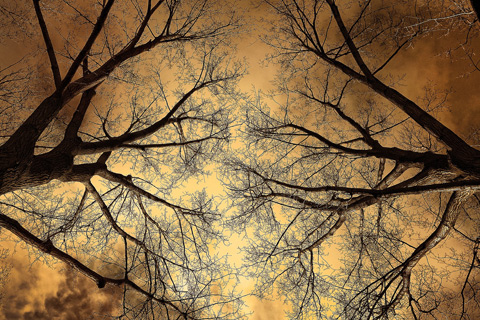
Trees get sick. Like any other living organism, a tree can fall ill for various reasons. If left to its own devices, it can eventually fall causing catastrophic damages.
When an otherwise healthy tree shows signs of illness or infestation, you must take action by eliminating the cause or calling on a certified arborist to evaluate the tree and offer a course of action.
The team of arborists at 72tree.com prepared a comprehensive list of 9 common tree health problems and their solutions.
Weather and Tree Health
Trees are affected by inconsistent weather patterns. The following demonstrates how weather impacts trees and how you can help them remain healthy.
1 – Drought:
One of the most common ailments of trees, symptoms of drought can be tricky. Sometimes, the signs won’t appear until as much as a year after the damage has been done. Those symptoms include:
•Drooping, wilting, and yellowing of leaves.
•Premature needle or leaf drop.
•Pronounced dieback.
•Thinning of the canopy.
•Deep cracks in the bark.
•Necrosis of leaves or browning of needles.
•Death of the tree.
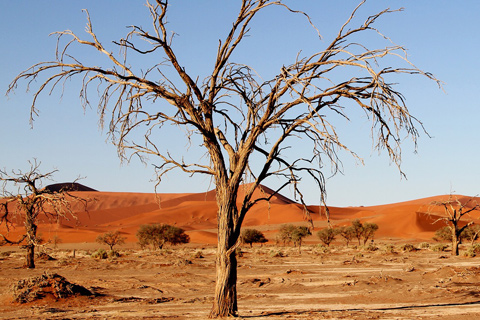
Solution 1 – For planting new trees, make sure they are appropriate for the USDA Hardiness Zone in which you are located. If your area experiences occasional or frequent droughts, seek drought-resistant species.
Solution 2 – Water your trees regularly. New trees will require a deep watering once a week for the first two years (to establish its roots). In addition to watering, add a 3-inch layer of organic mulch around the tree to help the soil retain its moisture.
After two years and through its adult life, trees are very capable of finding water sources. However, throughout dry summer months and near the end of fall, weekly deep watering and mulching will help prevent drought problems.
Solution 3 – Prune back all cracked, dead or weakened tissue. Without pruning these troubled areas, the tree will become vulnerable to infection and infestation. Call on an arborist when pruning removes more than 25% of the tree’s canopy or mass. They can assess the tree and offer a course of action.
2 – Winter Burn:
Also known as desiccation, winter burn occurs primarily in evergreens and causes a discoloration of the foliage. Effects of winter burn are more pronounced where the tree is exposed to the sun and wind. This affliction requires the presence of the following three factors:
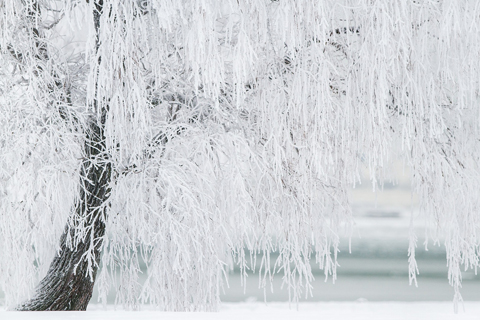
•Freezing temperatures
•Dry soil
•Wind
Solution – Provide your trees with weekly deep waterings through the end of fall and beginning of winter (before the ground freezes) and mulch the area of the root zone for the soil to retain moisture.
For trees that are highly exposed to the wind and sun, wrapping them with burlap will provide an effective barrier which can be removed as temperatures rise.
3 – Improper Pruning, Trimming, and Cutting:
There is a right way, and a right time to perform tree pruning, cutting, or trimming. When performed improperly, the tree may be left exposed to infection and infestation. When done at the wrong time, new growth may not have enough time to adapt before winter, further stressing the tree.
Solution – Know when to prune. Depending on the species of your tree, it may be better to prune in early spring, late fall, or even in the summer months. Use proper pruning or cutting methods when removing limbs, branches, or stems.
Watch this video to learn more about proper pruning techniques.
Tree Insect Infestation
For the most part, healthy trees can stave off insect infestations. However, when a tree’s health is weakened, or there is an increase in the insect population, no tree is off limits.
4 – Insects on Leaves and Bark:
Insects such as aphids, inchworms, bagworms, spider mites, lace bugs, and tree scale are common and relatively easy to manage.
Solution – Apply insecticidal soap, neem oil, or a horticultural oil directly on the area of the infestation.
5 – Boring Insects:
Insects such as the Emerald Ash Borer, Japanese Beetle, Southern Pine Beetle, and Ambrosia Beetle are more complicated to control. You can identify boring insect activity by seeing “sawdust” from their boring activity and the entry hole they create when entering the tree.
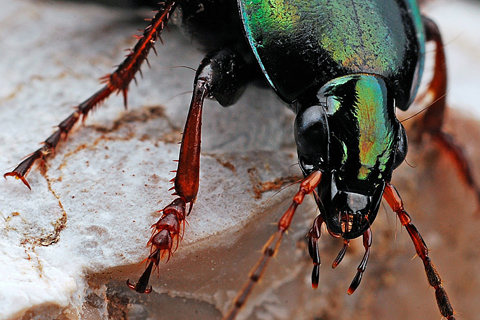
Note: Do not inject insecticides, poisons, or other substances into boring insect entry holes. The chemical may end up further damaging the tree leaving it more susceptible to infestation and death.
Solution 1 – Prune back branches and stems that have been infested and destroy them to prevent further spreading. If more than 25% of the tree’s foliage or mass must be removed, seek the assistance of a certified arborist.
Solution 2 – When the infestation is in the trunk of the tree, call an arborist to evaluate the damage and determine a safe approach to halting the infestation.
Solution 3 – Prevent infestations by keeping your trees healthy. When you hear about an outbreak in your area, treat your trees with a bark insecticidal spray to deter the insects from making your tree its host.
Tree Fungal Diseases
Most fungal diseases make their way into a tree through the roots and open wounds. Once a tree is widely infected, it becomes challenging to control the fungi and will often result in the removal of the tree.
6 – Fungal Infection (internal)
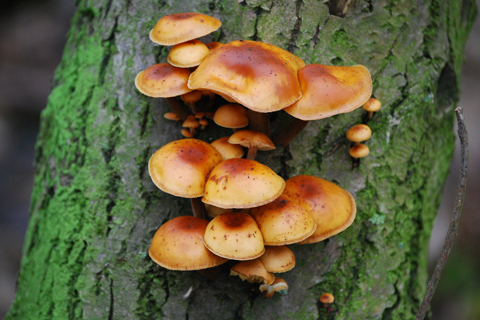
The most alarming sign of fungal trouble is when mushrooms grow on the trunk or branches. Since they require decaying matter to develop, there is a serious issue at play.
Note: The introduction of herbicides to a wounded tree or beneath the bark will only serve to accelerate the death of the tree.
Solution 1 – Prune back and destroy affected foliage, limbs, and branches. Again, when more than 25% of the tree’s foliage or mass must be removed, seek the assistance of a certified arborist. The removal of the tree may be the only way to keep your other trees from being infected.
Solution 2 – Properly prune your healthy trees (or have them pruned) to keep them healthy. A poorly pruned tree is more susceptible to both insect infestation and fungal disease.
7 – Fungal Infection (external)
The wind, birds or insects often carry spores of fungi and pathogens from tree to tree. Cankers, fire blight, rust disease, powdery mildew, and many others are common in the spring and summertime.
Solution – Carefully prune back and destroy affected foliage and apply a fungicidal spray to the affected and surrounding areas. Surrounding trees and shrubs should all undergo treatment as well.
Watch this video to learn about pathogens such as fire blight and cankers which affect tree bark and foliage.
Tree Problems Caused by People and Machinery
All of the threats mentioned above aside, people pose the most significant threat to a tree’s livelihood either by lack of knowledge or accident.
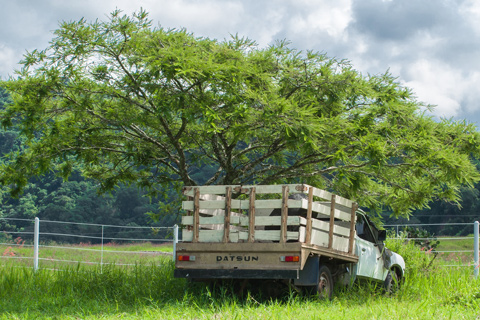
8 – Soil Compaction:
The land that surrounds a tree (especially under its canopy) contains the majority of the roots that draw water for the tree. These roots grow within the top 12 to 18 inches of soil. When this area is compacted, these roots suffocate and die, severely weakening the tree.
Trees compromised by soil compaction are at a heightened risk of toppling in a storm or severe weather event, as their roots are no longer effectively able to anchor them to the ground. Many times, no storm is required, the tree will eventually succumb to its own weight and fall on its own.
Solution – Never drive or park any vehicles underneath a tree’s canopy. Likewise, never store heavy equipment, or erect tool sheds under a tree.
In most municipalities nationwide, tree protection ordinances mandate that protective barriers be placed around trees on construction sites to deter such activities.
The majority of those same ordinances impose heavy fines and replanting requirements known as a recompense for damaged or removed trees.
9 – Lawn Mowers, Motorized Equipment, and Bark Damage:
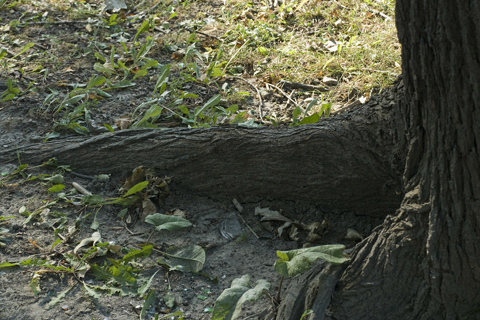
Below the bark of a tree and outer layer of roots, there is a thin layer of cells called the “phloem” which is the conduit for nutrients traveling up and down the tree.
When a tree’s bark is damaged, not only is the tree susceptible to infection and infestation, that flow of nutrients is interrupted and if the damage is around the majority or entirety of the trunk, the tree will be girdled and die.
Solution 1 – Do not allow lawn mowers and other equipment to damage protruding roots or the bark of the tree.
Solution 2 – For protruding roots, either raise the ground level to bury them, or carefully prune them. If you choose to prune the roots, call on a tree professional for detailed instruction or to do the job. Just cutting them out may result in the decline of the tree’s health and its death.
Solution 3 – If the bark of a tree is dried, cracked, or knocked loose, DO NOT remove it. Call an arborist to evaluate the tree’s situation.
Healthy Trees and Arborists
All arborists would agree that healthy, well cared for trees are capable of resisting most infestations and illnesses on their own. However, when a tree does present signs of trouble, knowing what to do can mean the difference between life and death for the tree.
Whether the troubles come from weather, insect, fungi, or people, the solutions are usually simple when detected and treated early. In many cases, to prevent the spreading of a pathogen or the demise of the tree, a certified arborist should be called in to assess the situation and determine a safe course of action.
When your trees show signs of trouble, doing nothing or hesitating to correct the problem may result in the decline of the tree’s health or even its abrupt death.
Sources:
https://www.treesaregood.org/treeowner/planthealthcare
http://www.missouribotanicalgarden.org/gardens-gardening/your-garden/help-for-the-home-gardener/advice-tips-resources/pests-and-problems/environmental/winter-injury/desiccation-or-winter-burn.aspx
https://www.arborday.org/trees/health/issues.cfm
Notice: Undefined variable: page in /home/vrxdg1855sn3/public_html/wp-content/themes/72tree/content.php on line 15
Notice: Trying to get property 'ID' of non-object in /home/vrxdg1855sn3/public_html/wp-content/themes/72tree/content.php on line 15
Crape Myrtle – A Southern Tree for Your Alpharetta and Roswell Yard
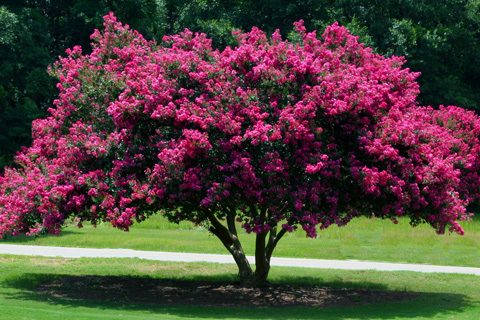
Lagerstroemia, known as crepe myrtle or crape myrtle is a tree that thrives in US Hardiness zones 7 through 10, making it a perfect choice for your Alpharetta or Roswell yard. The genus came to the US over 200 years ago and got its name from the Swedish merchant Magnus von Lagerstrom.
The most popular species is L. indica. It is a native of southern China and Thailand. For centuries, crepe myrtles have been grown in Asia as ornamentals.
Of all the southern trees and plants, crepe myrtles are among the most desired for their outstanding summer display of blooms and their brilliant fall colors. 72 Tree, Seed & Land Co. prepared an extensive article covering the characteristics, environment, and care these trees need to flourish and light up your landscape.
Are Crepe Myrtles Trees or Bushes
The Lagerstroemia genus contains approximately 50 species of trees and shrubs both deciduous and evergreen. So, this species can indeed grow as a tree or shrub, making it ideal for hedges, container planting, or even in groupings along your landscape.
Height – The L. indica species possesses cultivars and hybrids that remain under 5ft in height, some that reach 11 to 15ft in height, and those that tower over the others, reaching heights of 20 to 30ft.
Canopy – At maturity, the canopy can reach from 6ft to well beyond 15ft depending on the species.
Trunk – Crape Myrtles are known to have multiple trunks with beautiful bark which exfoliates in the winter months. Be cautious when pruning or working around these trees, their wood is somewhat brittle, and the trunks may easily crack when put under pressure.
Lifespan – When planted in full sun and fertile soil, Crepe Myrtles can live well beyond 50 years. In fact, dotted along the southeastern landscape, it is common to come across specimens over 100 years old.
Uses – Depending on the species, these trees work as shrubs, hedges, container plants, landscape groupings, and in some cities as street trees.
If you decided you prefer to plant an evergreen instead, visit 72tree.com/3-evergreen-species-alpharetta-roswell-yard/ for some great candidates.
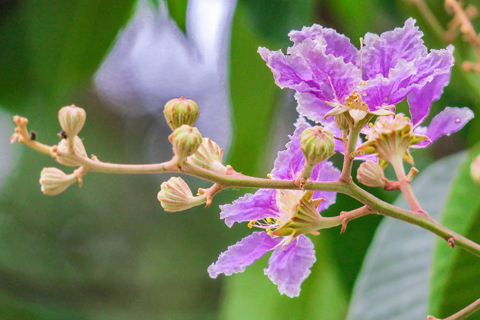
Crepe Myrtle Tree Care
About two years after planting, these species become very tolerant to drought, heat, humidity, and will do well in nearly any well-drained soil. They become robust enough to resprout even after being completely frozen.
Crepe myrtles are low maintenance. However, you still need to do some planning before planting and a bit of upkeep as they grow.
Planting – Location is critical when planting crepe myrtles. Select a spot that has well-drained soil and gets full sun. Planting in partial or full shade will significantly reduce its ability to flower and may reduce its lifespan as well.
Crepe myrtles have a shallow and very fibrous root system which can extend 3 to 4 times the diameter of the canopy. As with all trees, the planting location should be at least 5 to 10 feet away from cement pathways, foundations, and sidewalks.
Pruning – Very little pruning is required. Improper pruning disrupts the development of a robust branching system and will leave your specimen deformed and vulnerable to weather, pests, and fungi.
If there is a need to prune, it should occur in late winter or early spring to correct the following:
• Removing crossed or rubbing branches.
• Removing suckers from the base.
• Branches growing inward (toward the center).
• Canopy thinning for better air circulation.
• Gradually remove side branches up to 4 or 5 feet as the tree grows.
• Reducing multi-trunk trees to a single trunk (not recommended).
Summer pruning can include:
• Removing old seed pods and spent flowers (removing them after the first bloom encourages further blooming).
• Removing small twig-like growth.
All crepe myrtle species bloom on new wood. The proper and minimal pruning of your tree will encourage this growth and promote a beautiful summer blooming season.
If you are pruning your tree because it has gotten too large for its location, you’ve planted the wrong species.
Watering – Provide newly planted crepe myrtles with a deep and thorough watering. Then, water your tree up to 4 or 5 times per week during hot weather or when planted in sandy soil. When the tree is dormant or during cold weather, your tree will need watering once per week.
Blooms – As previously mentioned, all crepe myrtles bloom on new wood. After the first bloom, removing the spent flowers will encourage further blooming in the season.
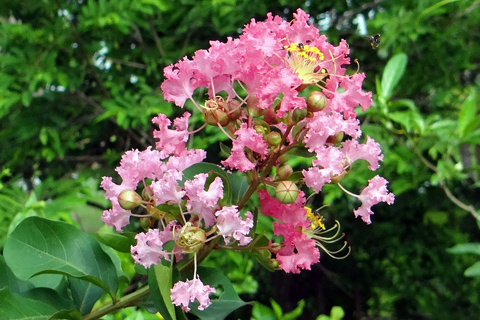
Tree Pests and Disease That Attack Crepe Myrtles
These trees like all others on your landscape are susceptible to infestations, disease, and animal damage. The best defense against these threats is to keep your tree(s) healthy, plant, prune, and water them properly and they will be less likely to suffer damage from the following:
Pests that infest crepe myrtles:
Japanese Beetle – This insect is approximately 1/2 inch in length, its body is oval and metallic green, and its wings are copper in color.
Larvae remain underground where they consume grass and young tree roots. Adult beetles feed on the tissues of the leaves and are most active on trees in full sun during the warmest part of the day.
A Japanese beetle infestation can cause severe damage to all of the trees on your landscape. Traps, pyrethrins, and neem oil can help curtail a beetle outbreak. However, this is an urgent situation which needs to be evaluated by a certified arborist.
Crape Myrtle Aphid – These insects are yellowish-green and have black spots on their abdomen. They measure from a sixteenth to an eighth of an inch in length.
Both nymphs and adults feed on the underside of the foliage causing it to droop and yellow leaf spots to appear. Buds, flowers, and branch tips can all be damaged as well from their feeding.
Sooty mold will appear on the leaves when there is an aphid infestation. This mold is a byproduct of the aphid’s excrement and will disappear once the outbreak ends.
Watch this video to learn how to eliminate aphids and “black” sooty mold on your crape myrtle.
When a crape myrtle aphid infestation occurs, apply a 2oz. to 1 gallon solution of molasses and water to the affected areas and release ladybugs around the tree. Neem oil is also very useful in controlling aphids.
Fungi that attack crepe myrtles:
Powdery Mildew – This fungus appears as a white powdery substance and can spread very quickly if not handled properly.
It is worth noting that trees planted in full sun are not typically bothered by this fungus.
To control powdery mildew, spray a fungicide on the affected area and its surroundings.
Sooty Mold – This mold has a tar-like appearance and is a result an aphid infestation (see above).
Bark Shedding – Don’t be alarmed. While it may seem that something has infected your tree, there is nothing wrong with it. Crepe myrtles, once reaching adulthood will naturally exfoliate their bark in winter months, revealing the magnificent color variations of its trunk.
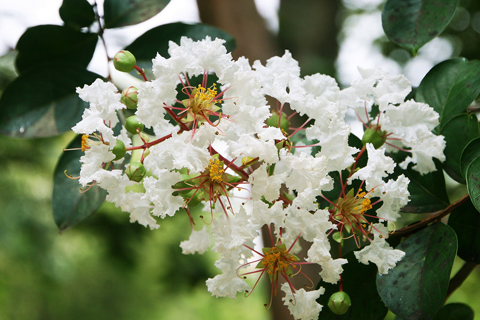
Crepe Myrtles and Summer Blooms
If you are looking for an incredible addition to your Alpharetta yard or landscape, crepe myrtles are a must have. Besides being low maintenance, they will put on a colorful show every summer.
An added plus in the summer is when the blooms attract birds seeking refuge and nesting and offer their nectar and pollen to the bees.
Sources:
https://en.wikipedia.org/wiki/Lagerstroemia
https://www.leugardens.org/wp-content/uploads/2014/07/Crepe_myrtles.pdf
https://crapemyrtletrails.org/crape-myrtle-history/
http://www.pcmg-texas.org/images/trees/crape_myrtle_pest.pdf
https://crapemyrtletrails.org/pest-control/
Notice: Undefined variable: page in /home/vrxdg1855sn3/public_html/wp-content/themes/72tree/content.php on line 15
Notice: Trying to get property 'ID' of non-object in /home/vrxdg1855sn3/public_html/wp-content/themes/72tree/content.php on line 15
3 Evergreen Tree Species for Your Alpharetta and Roswell Yard
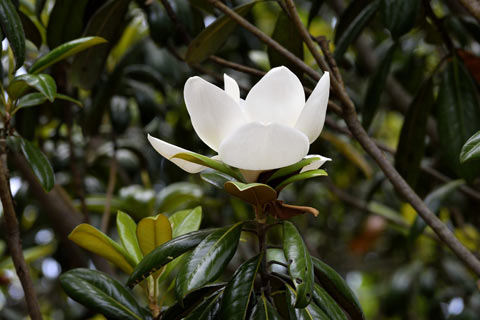
The difference between evergreen trees and deciduous trees becomes very obvious in the fall. Evergreens stay green and keep their foliage, while deciduous trees typically change the color of their leaves before dropping them and going dormant.
Evergreen trees do drop foliage, just not all at once. Throughout the year, they will drop small portions of their foliage and grow it back. These trees do not experience a dormant period like their deciduous counterparts, but they do slow down in the winter months.
For those with an aversion to raking up leaves in the fall, the arborist at 72tree.com identified 3 evergreen tree species to enhance your Alpharetta and Roswell Ga landscape.
Pine Trees
Of the North American native tree species, pine trees are one of the most widely spread and varied classes. Because of their ability to adapt and the ease to care for them, pines remain very popular landscaping trees from coast to coast.
Height – Within the pine family, some of the species can reach an astounding 150 feet tall and live to be more than 450 years old.
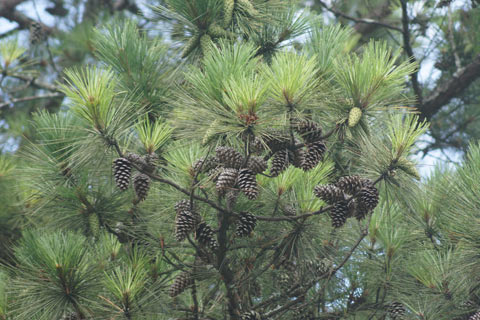
Crown Width – Mature pine tree canopies can stretch from 15 t0 30 feet in diameter depending on the species and the environment it is planted in.
DBH – When pines such as these reach maturity, their trunk DBH (diameter at breast height) can measure from 2.5 to 4 feet. As with most trees, there is just as much happening below ground.
Root System – As pines develop an extensive, deep, expansive, and invasive root system, they should not be planted within 20 feet of permanent structures like fences, underground utility lines, or homes.
Pest Problems – Bark beetles, aphids, and bagworms are a few of the pests that enjoy making a meal of pine trees. Mites and tree scale are also likely.
Disease – Some of the more common diseases that affect pine trees are needlecast, root rot, and pine wilt.
Pesticides and fungicides can be used to curb the progress of these pests and diseases. However, in cases of severe infestation and infection, an arborist should be called to evaluate the tree and what actions should be taken (including the tree’s removal if necessary).
Magnolia Trees
This classic Southern beauty (magnolia grandiflora) is very distinctive with its wide glossy leaves and enormous fragrant white blossoms. When it comes to year-round beauty, there are few trees that can keep up with it.

Its full luxurious look has made it a popular ornamental around the world.
This tree, although evergreen will drop leaves throughout the year. Growing anything beneath this tree (including grass) is difficult due to its dense foliage casting full shade and its shallow roots.
Height – A magnolia tree planted in a location with rich soil, little to no obstacles for the root system, and good soil drainage can reach heights of more than 80 feet.
Crown Width – While this tree possesses a pyramidal to rounded crown at the top, its width can reach 30 to 40 feet at the base and mid section.
DBH – Adult magnolias can reach a DBH of 24 to 36 inches. To reach this size takes anywhere from 80 to 100 years.
Root System – The species itself is a deep rooted one. First to develop is a strong tap root, then as the tree grows, many sunken roots will grow down from the root collar, and as the tree ages, major lateral roots will grow. When planted in areas with a high water table, the roots will grow more shallow and outward.
The optimum soil for this species is a rich, well drained, and slightly acidic one. When planting a magnolia, add generous amounts of organic material to the soil for the best growing conditions.
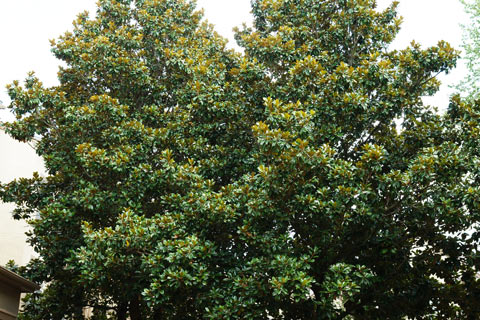
Although magnolia roots are not considered invasive, when planted too close to sidewalks or foundations, they will eventually cause undesired cracking and buckling.
Pest Problems – Varieties of scale, aphids, striped mealybug, spider mites, and magnolia leafminers are all potential infestation culprits.
Disease – There are a number of fungi which cause leaf spots. For the most part, they are unable to cause any significant damage to adult magnolias.
As well, there are a number of Polyporus fungi and Fomes which can cause heart rot.
Again, pesticides and fungicides can be used to curb the progress of these pests and diseases. When a severe infestation or infection is detected, an arborist should be called to assess what actions should be taken.
Eucalyptus Trees
Of all of the evergreen trees you could want in your yard, eucalyptus should be at or near the top of the list. This species is a fast growing, insect repelling, and gorgeous tree that adds beauty and practicality to whatever landscape it grows in.
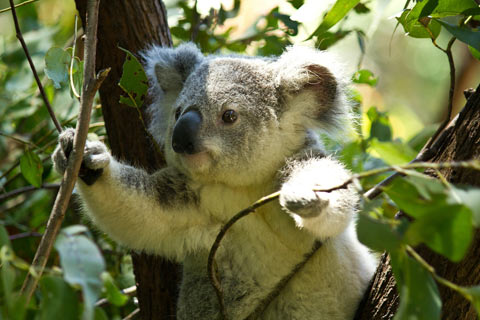
For most, the image you get when you hear “eucalyptus” is a koala bear latched on to a branch, munching away at the leaves. You may be surprised to learn that only the koala, some possum species, and a select few insects are actually able to consume parts of this species. In large quantities, this tree’s secret weapon (cineole) is toxic.
It is the cineole aka: eucalyptol in eucalyptus trees that make up the greatest part of its signature aroma. Eucalyptus essential oil has been used for centuries in the treatment of respiratory ailments, as a disinfectant, and as an antibacterial or anti-fungal agent in medicine.
Height – Eucalyptus tree sizes vary. Their height at maturity can range from 30 to 35 feet for smaller varieties all the way to over 200 feet for the tallest of the species.
These trees must be planted away from physical structures. Mature eucalyptus trees are known to unexpectedly drop branches.
Crown Width – The eucalyptus tree species will typically grow tall and relatively slender, with mature crowns reaching from 12 to 30 feet in diameter. Many varieties of the species are able to reach much greater diameters as they age.
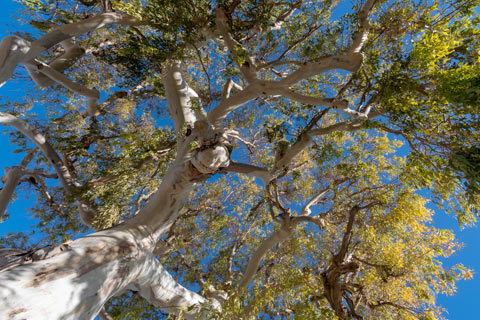
DBH – Adult eucalyptus trees can reach a DBH of 15 to 20 inches.
It is worth mentioning that this species is able to reach maturity within 10 years of growth. That’s less than half (in some cases less than a third) of the time it takes for the majority of other species to reach maturity.
Root System – This species quickly adapts to the soil it is planted in. In rich, fertile soil, the roots have no need to go deep. The tree is on a fast track for height and the roots will spread horizontally staying close to the surface.
In more nutrient deprived soil, the roots will dive deep for their food and moisture source. Counterintuitively, it is the eucalyptus planted in poor soil that grows to be the more stable and wind or storm resistant.
Pest Problems – Little to none (as long as the tree remains healthy). High concentrations of cineole in all parts of eucalyptus trees acts a natural insect repellant.
Two species of Australian tortoise beetles (family Chrysomelidae) (still isolated in the west) chew semicircular holes or notches on edges of eucalyptus leaves.
These beetles are able to remove most of a leaf’s surface, leaving only the midvein.The damage caused by these beetles is unsightly but not life threatening to the tree.
If a tree is stressed enough, an opportunity opens up for the eucalyptus longhorn borer. The female of this species lays her eggs on stressed trees, producing larvae that burrow their way to the cambium layer.
A heavily infested tree can die within weeks, which is due to the larval galleries girdling the tree and disrupting the flow of water and nutrients.
Infestations must be treated immediately. Because of the speed at which death can occur, an arborist should be called to evaluate the tree and determine what actions to take.
Disease – Canker, heart rot, and Phytophthora can infect a stressed eucalyptus tree. All three of these fungi attack and damage the tree from the inside.
Signs of infection are discolored leaves and in severe cases, splitting of the trunk. In any of these cases, the tree should be removed, destroyed (burned) and all equipment disinfected to prevent the disease from spreading to other trees.
Tree Care for Evergreens
As long as evergreens are planted in hardiness zones where they can thrive and get ample summer sunlight and winter shade (possibly on the north side of your property), caring for these trees is relatively simple.
Water them regularly and mulch around their trunk. This will keep them strong and winter injury resistant. Evergreens (when not mulched or watered well) can be severely injured by the drying effects of the sun and wind through winter months.
A major benefit of evergreens in your yard is that there is no bad season. Even during the coldest days of winter, your landscape will be filled with full, and vibrantly-green trees.
Sources:
http://ipm.ucanr.edu/PMG/PESTNOTES/pn74104.html
http://homeguides.sfgate.com/care-maintenance-evergreen-trees-59096.html
https://en.wikipedia.org/wiki/Salix_babylonica#Horticultural_selections_and_related_hybrids
https://gardenerdy.com/types-of-evergreen-trees
https://www.ambientbp.com/blog/7-facts-eucalyptus-trees
Notice: Undefined variable: page in /home/vrxdg1855sn3/public_html/wp-content/themes/72tree/content.php on line 15
Notice: Trying to get property 'ID' of non-object in /home/vrxdg1855sn3/public_html/wp-content/themes/72tree/content.php on line 15
5 Tree Pests and Diseases to Avoid this Spring
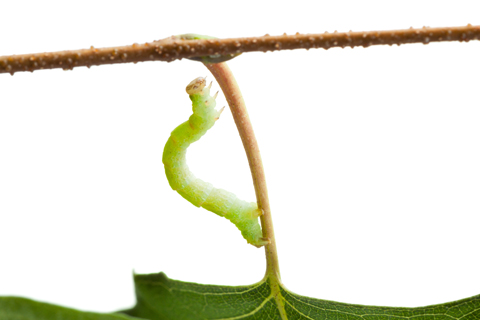
Spring has arrived and with the new season comes new tree problems. It isn’t just the flowers blooming, trees budding, and pollen everywhere; tree pests and diseases are coming alive as well.
Generally, when winter weather and lower temperatures are sustained throughout the season, pests and disease won’t pose much of a threat in the spring. This year however, winter weather and temperatures were relatively mild, favoring the spread of disease and increasing pest population. It’s just the beginning of the season, and there is great potential for tree damage this spring.
The arborist at 72 Tree, Seed & Land Co. identified 5 common tree killers, and methods to get them under control this spring. Also being discussed are routine tree and landscape inspections, pest and disease prevention, and ongoing tree care throughout the year.
3 Common Spring Tree Pests
While there are a wide variety of tree pests, the following have been singled out due to the extent of the damage they can cause. So take heed because, the damage often goes unnoticed until removal of the tree is necessary.
Bagworms – If the leaves on your tree are turning brown or the needles are falling off of your pine, the culprit may be bagworms. Your tree is their food, and as they consume, your tree is unable to produce vital nutrients to keep it healthy and alive.
These worms make a bag-like nest (thus the name) which is often mistaken for a pinecone. In the fall, they mate and each female bagworm is able to lay over 500 eggs that hatch in mid spring.
There are two effective ways of controlling bagworms. You can physically remove and destroy the “bags”, or apply a pesticide in the spring as they are hatching. Once you have confirmed that bagworms have invaded your landscape, you will likely need the help of a professional tree service to keep them under control.
Cankerworms – Also known as inchworms, cankerworms chew away at the foliage of your trees. There are two species of this pest “fall cankerworm” and “spring cankerworm” but don’t let the name mislead you, they both hatch in the spring and feed on the same trees.
The damage they inflict on trees is more stress related and potentially leads to dieback, borer damage, and even root decline. For a healthy tree, one year of cankerworm defoliation won’t necessarily result in the loss of the tree. However, multiple years of defoliation will weaken the tree, making it susceptible to other pests that can ultimately lead it to its death.
When there is a breakout of this pest, there are two principle treatments.
1) Banding the trees in the fall (the wingless females stick to the band and cannot reach the canopy to deposit their eggs) is one very effective measure.
2) The other is the use of pesticides shortly after the worms have hatched. This measure is only effective while the worms are small and should be monitored by an arborist to ensure proper control is achieved.
Southern Pine Beetle – (Dendroctonus frontalis) These boring tree killers are known as the most destructive forest insect in the southern states. The signs or symptoms of an infestation are severe dieback, browning, and eventual death of entire limbs, foliage, and the tree itself.
Once this beetle attacks and succeeds at making a tree its host, the adults emit a pheromone attracting other beetles to the tree. In a matter of days, a tree’s defenses can be overrun by thousands of beetles. As one tree becomes overpopulated, the beetles will seek out nearby trees to colonize, thus expanding their population and local infestation potential.
It is the older and weakened trees that are more susceptible to beetle infestation. Control is accomplished by promoting the health of your trees, and when there is a breakout, applying insecticides to the tree bark is an alternative.
If you have a tree affected or infested by southern pine beetles, you will need an arborist to help identify witch, and if measures can be taken to thwart the infestation.
2 Common Spring Tree Diseases
Throughout the lifecycle of a tree, it may be faced with a number of fungal invaders from its roots to its leaves. While a tree builds a natural resistance to these invaders, trees are not completely immune and can be severely debilitated. The following tree diseases are ones that should be addressed immediately after being diagnosed.
Fire Blight – (Erwinia amylovora) Is a contagious plant disease. Blight is a hard to control pathogen that robs plant and tree foliage of its nutrients, causing the blackening and death of that foliage. Fire blight differs from dieback in that it leaves behind the appearance that the foliage has burned. Thus the name.
Blight is most successful in the springtime, as temperatures and humidity remain ideal for its growth. As with other pathogens, it is spread from host to host by physical contact, insects, birds and other wildlife; be careful when working in the garden because even the tools used for landscape maintenance can transmit fire blight disease.
Moreover, there is no known cure for blight. Control is achieved by pruning and destroying the affected foliage and limbs. The use of pesticides can also aid to control the pest population. As stated, the proper cleaning of equipment after use is helpful to avoid its proliferation. While the planting of resistant or tolerant species is an effective and proactive approach to overcome this disease.
NOTE: When cleaning garden and landscape equipment after handling diseases such as blight, applying a bleach solution (1 part bleach to 4 parts water) to your tools is recommended to neutralize the pathogen.
In the following link we discussed preventing fire blight tree disease in more depth, so check it out for more solutions and detail of this devastating disease.
Heart Rot – Heart rot is a fungal disease causing the softening and decay of the wood found at the center of a tree’s trunk and branches. When you see mushrooms or fungus conks attached to the trunk or branches of a tree, it can be a strong indicator that heart rot is present within the tree.
Fungi enter the tree through damaged bark or poorly pruned ares, move to the heartwood, and begin the process of decay. Softening of the heartwood leaves trees structurally weak and prone to collapse or breakage.
Hardwood trees are affected by heart rot on a global scale, and is extremely difficult to prevent. However, if a tree is growing vigorously, it may be able to isolate the affected portion of itself through a process called compartmentalization.
Control of this destructive disease may be achieved by keeping your tree healthy through proper pruning techniques, annual inspections by an arborist, and post storm maintenance and pruning.
Routine Tree and Landscape Inspections
Tree and landscape inspections start with you. When you’re out mowing, watering, pruning, or playing in your yard, observe the plants, shrubs, and trees. Look for insect infestations, discoloration in the foliage, and dieback of the limbs and crown. For more on dieback and signs of a diseased tree, visit 72tree.com/signs-diseased-tree-dieback-suckers-water-sprouts/
Once a year, hire an arborist to thoroughly inspect your trees and the plant life in your yard. They are trained to spot potential health issues, and implement the best solutions to save and/or extend the lives of your plants.
Prevention and Continued Care
The best preventative maintenance for your trees and plants is the consistent and continued care that you provide them. Healthy plants have the strength to develop defense systems that ward off both pests and disease.
Proper and timely pruning, watering, and fertilizing will help your trees reach maturity faster and in a stronger and more resistant way.
Controlling Pests and Disease All Year
Every pest has its season and every season has its pests. As you have probably gathered by now, the best way to control pests and disease is by keeping your trees, shrubs, and plants healthy through remaining proactive and aware of their state.
Pest control will help in stopping the spread of pathogenic fungi and bacteria, as well as curbing some of the more voracious insects. Fungicides will also help keep many of the pathogens away from your landscape’s ecosystem.
Keep your trees healthy this spring and for years to come by knowing what to look for and which steps to take. And when something strange pops up, call on your local arborist to address and get it solved.
Notice: Undefined variable: page in /home/vrxdg1855sn3/public_html/wp-content/themes/72tree/content.php on line 15
Notice: Trying to get property 'ID' of non-object in /home/vrxdg1855sn3/public_html/wp-content/themes/72tree/content.php on line 15
Tree Pruning Techniques
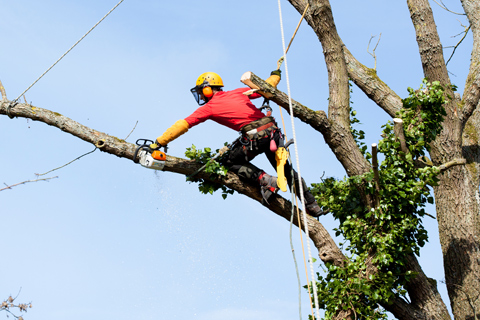
Your trees are constantly responding to environmental changes and throughout the year, they will need some help by way of pruning.
Tree pruning will help to improve the overall health of your trees, their overall appearance, and naturally reduces the possibility of tree failure. The improper pruning of a tree can stress a tree leading to potential decay, infestation, disease, and even death.
Below the arborist at 72 Tree, Seed & Land Co. discuss the different ways trees can be properly pruned.
Tree Height Reduction
When reducing the height of a tree, much care and precision pruning are necessary.
This procedure must be done correctly; “topping” or cutting through the main trunk often leads to several issues for the tree including failure.
Depending on the species and growth pattern of the tree, height reduction may not be possible without irreparably damaging the tree. In these cases, the choice to remove or relocate it may have to be made.
Tree Crown Raising
Crown raising involves the pruning, cutting, or removal of the lowest branches of a tree. This procedure provides more clearance under a tree for people and vehicles.
This procedure, when performed on younger trees, will encourage more growth in the upper branches. When raising the crown on older more developed trees, much caution is needed as the lower branches will be much larger and leave larger wounds.
Tree Crown Thinning
Crown thinning is a wise option for trees that sustain the full force of strong winds or have to bear the weight of accumulated snow or ice.
This is accomplished by the selective and careful removal of branches from within the crown. This process reduces the force of the wind on the canopy, as well as reducing the weight of snow and ice on the tree.
Care must be taken when thinning a crown. The improper procedure or over thinning can lead to disease, decay, infestation, or make the tree more susceptible to being blown over.
Tree Crown Cleaning
As the name suggests, crown cleaning is the removal of dead and dying branches. Crown cleaning is the more common of the pruning options.
This procedure helps to protect your tree by removing unnecessary weight, reduces the risk and hazard of falling branches, helps to halt the progression of decay and disease, thus improving the overall health of the tree.
Small or Ornamental Tree Pruning
Small or ornamental trees should be routinely pruned for many of the same reasons mentioned above. They may also be pruned for simple esthetics or to train them as they grow.
Professional Regular Pruning
Once aware of the signs your tree needs pruning, having your trees regularly pruned by a tree service or certified arborist will keep your trees healthy and beautiful. This will also benefit your landscape by the early detection of problematic infestations, fungi, or irregularities that may otherwise go unnoticed until it’s too late to correct.
An added benefit to regular pruning services is curb appeal. The better your landscape appears, the more curb appeal your property will have. This usually translates to a higher property value.
Overall, pruning is beneficial and necessary throughout the year. Follow these tree pruning tips, and visit our tree care blog more articles and information.
Notice: Undefined variable: page in /home/vrxdg1855sn3/public_html/wp-content/themes/72tree/content.php on line 15
Notice: Trying to get property 'ID' of non-object in /home/vrxdg1855sn3/public_html/wp-content/themes/72tree/content.php on line 15
My Tree is Dying from the Top Down
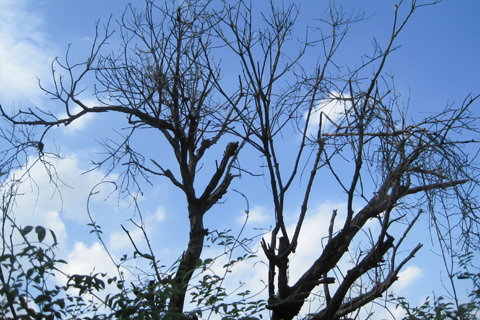
What causes a tree to die from the top down? A common reason for a tree to die from the top down or from its outer limbs is drought. Even with reasonable rainfall, your tree may not be getting the water it needs to thrive and survive.
When a tree begins to deteriorate from the top down, this condition is also known as dieback. Dieback is the gradual death of tree branches, foliage, and/or limbs starting at the tips (extremities) and moving inward toward the trunk. Dieback, as mentioned above may result from drought. However, there may be a variety a variety of causes contributing to the gradual death of your tree.
The following will help you to identify what is causing dieback, the options available to save the tree, and the actions you can take to prevent the tree’s death.
What Can Cause Dieback from the Top Down?
In order to identify the cause of dieback, you need to know what you are looking for. The following are common reasons and symptoms when tree health declines.
Drought – Symptoms include the wilting or discoloration of leaves, limb, twig, and branch dieback, as well as the death of roots. Trees suffering from drought are very likely to be affected by insects, disease, or both.
Soil Imbalance – Soil is composed of minerals, organic and inorganic matter, water, air, and has an acidic or alkaline pH level. When an imbalance of these levels occurs, nutrients needed for the tree’s survival may not be absorbed. This can certainly lead to dieback and death of the tree if not addressed.
A sure sign of soil trouble is the absence of worms, plant growth, and small insects. “Life” should be detected in your soil, if not your soil’s health needs attention.
Insect Infestation – Invasive insect species also cause or accelerate dieback. When trees are stressed, they produce more amounts of nitrogen, potassium and phosphorus. This in turn makes them more attractive to invasive insects that feed off them.
As an infestation grows, the tree becomes more stressed and in turn, produces more of the chemicals – attracting more insects. This process can become a self-reinforced loop, and the initial stressors now combined with the infestation will eventually lead to the death of the tree if not treated promptly.
NOTE: While trees have adapted their defenses and healing processes over the millennia, it is these same adaptations that may feed an insect infestation.
What Options Do I Have to Save My Tree?
For each of the causes listed above, there is a specific course of action to halt or even reverse it. Once the cause is identified, the following simple treatments may help to save your tree.
Drought Treatment – During dry seasons or when rainfall is scarce, give your trees a thorough watering once a week. Make sure that the soil is soaked to a depth of at least twelve inches. Mulching around your trees base will slow the evaporation process and help the soil and tree retain moisture.
Soil Imbalance Treatment – While calling in a Certified Arborist may be the best option here, you are perfectly capable of getting a soil test kit from your local nursery or home improvement store (gardening department). Use the kit to determine if there is an imbalance for the species of affected tree(s), then seek appropriate soil treatments to return the soil to a healthy composition.
Insect Infestation Treatment – Once an infestation is confirmed, insecticides, traps, and oil can be used to kill the existing insects and prevent further infestation. Read this 72tree.com/using-dormant-horticultural-oil-treat-tree-insect-infestations/ for more on using and applying oils to treat insect infestations.
It is important to note that insect infestations are typically the result of a tree already stressed or in bad health. Once the infestation has been dealt with, begin looking for other stressors that may have lead to the weakening of the tree’s health.
How Do You Save a Dying Tree?
When dieback occurs, saving your tree will involve pruning or trimming off the dead parts of the tree, and identifying the reason that the dieback occurred. Once identified, treat it. If it is an infestation that is threatening other trees and plants, you may have to make the decision to completely remove the tree to prevent further contamination and damage.
Proper Treatment and Prevention – Once you have treated the cause of your tree’s dieback, understand that you can save a dying tree by simply paying attention to it through the seasons. Your tree will show signs of stress, and once you detect it, consider it a call to action.
It is equally important to establish and follow seasonal maintenance and care. Bringing in a Certified Arborist or reputable tree service to inspect your trees and landscape will help give you the upper hand in keeping your trees healthy!
Notice: Undefined variable: page in /home/vrxdg1855sn3/public_html/wp-content/themes/72tree/content.php on line 15
Notice: Trying to get property 'ID' of non-object in /home/vrxdg1855sn3/public_html/wp-content/themes/72tree/content.php on line 15
Tree Roots Are Buckling My Concrete Driveway
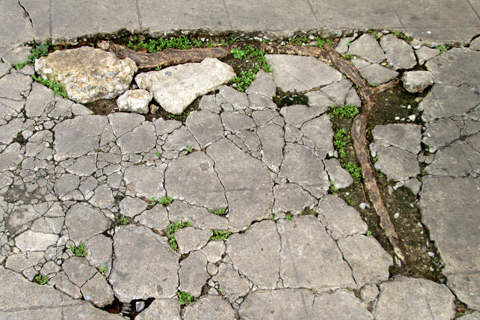
Tree roots constantly seek a water source, in doing so, they can spread very deep or very shallow and in a very large radius from the trunk. When roots spread at shallow depths, they will find their way under asphalt, sidewalks, and yes, driveways.
As the roots naturally expand and thicken, they will displace everything around them creating tremendous potential energy. This energy is usually released upward (path of least resistance), resulting in the breaking, cracking, warping, or buckling of whatever structure is above.
Here, we will discuss measures you can take to repair damaged concrete, remove damaging roots, and how to avoid this issue in the future.
How Much of the Tree’s Roots Can Be Removed
The answer to this isn’t quite as simple as it may seem. Here are some factors to consider:
Tree Roots Three Inches or More in Diameter – When cutting roots this size, they typically will not grow back. However, a wound this large leaves the root susceptible to insect and disease. Often times, this allows rot to reach all the way back to the trunk, seriously compromising the health of the tree.
Tree Roots Less Than Two Inches in Diameter – Tree roots this size are typically able to regenerate. Removing them will only e a temporary fix.
Tree Roots Grow Far and Wide – Typically, you will find that one inch converts to about a foot and a half. That is, for every inch at DBH (Diameter at Breast Height – measured 4.5 feet above the ground), the roots will extend up to a foot and a half away from the tree trunk. A twelve inch trunk at DBH means roots are extending up to eighteen feet away from the trunk in every direction.
Tree Roots Are Sensitive to Disturbance – Tree roots seek out uncompacted soil rich in oxygen (like the soil under sidewalks and driveways). When the soil underneath a tree is compacted by heavy machinery or used as a storage area for a construction site, the roots beneath the surface are literally being choked to death. Eventually, this will result in the decline of the tree’s health, leading to its death.
Tree Roots Under the Driveway – Roots provide structural integrity to a tree. If they have grown under the driveway, the driveway is now a part of its structural integrity. Depending on the size and depth of the roots, removing them may lead to the falling of the tree in severe weather.
More often than not, by the time tree roots have buckled your driveway, you may be faced with the ultimate removal of the tree, if you are to break up and re-lay the affected portion of the driveway.
How to Repair Your Driveway and Save Tree Roots
If the tree is a keeper in your landscape and the roots in question are vital to its survival, there are construction options or methods which will allow the coexistence of the roots and your driveway. Here is one of the multiple options you may use:
Aggregate Surfacing – This technique requires the cutting and careful removal of the damaged concrete. Once the concrete has been removed, the surface below is covered with driveway fabric (aka: geotextile fabric), then four to five inches of dense grade aggregate (DGA) or road stone. The project is completed by using edging along the sides to prevent the aggregate from spreading laterally.
Tree Species, Watering, and Location Matter
Ultimately, it is the lack of planning or the proper information to form a plan that lead to situations such as these. Before planting a tree, you should be aware of its species, potential growth, root spread capacity, and if its roots are typically classified as invasive or not.
Location is a key factor in the survival of any tree or plant. Planting a tree too close to a structure is like inviting a bull into a china cabinet. As trees grow, they instinctively seek out water sources, expand their canopies, and potentially wreak havoc on the structure they were planted next to.
Once a tree is planted, frequent watering will help its root system to grow deeper. Shallow root systems often reflect insufficient watering or compacted soil further beneath the surface.
To learn more about proper planting, see: http://treecareadvice.blogspot.com/2015/12/properly-planting-canadian-hemlock.html
Professional Tree and Tree Root Removal
While the solution you choose may be an easy one, innocent mistakes may lead to a much more serious situation as your tree’s health declines and ultimately dies.
Before any steps are taken to remove a tree or a portion of its root system, it is highly recommended to seek the advice of a certified arborist. An arborist is a tree professional trained to spot trouble pertaining to tree issues and how to efficiently resolve them.
Notice: Undefined variable: page in /home/vrxdg1855sn3/public_html/wp-content/themes/72tree/content.php on line 15
Notice: Trying to get property 'ID' of non-object in /home/vrxdg1855sn3/public_html/wp-content/themes/72tree/content.php on line 15
Power Line Interfering Trees & The City of Alpharetta Tree Ordinance
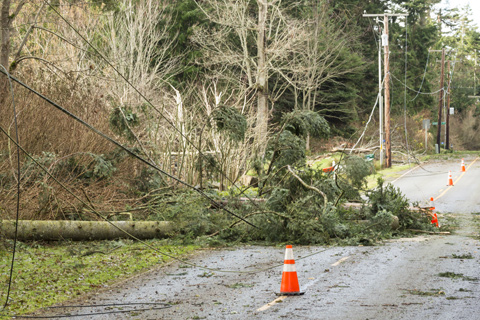
Whether you see trees interfering with power lines on your property or in the public right-of-way, it is important that you do not take matters into your own hands. When trees come in contact with power lines, they may break or bring the power lines crashing down. 72 Tree has seen this cause power outages in Alpharetta and notes these scenarios should be taken very seriously.
The trees are treated as seriously as the potential electrical hazard. The City of Alpharetta Tree Ordinance protects the city’s trees (both alive and dead) and imposes heavy fines for the unlawful cutting or removal of them.
Trees Interfering With Power Lines in the Public Right-of-Way
Alpharetta residents should report any tree on public property which poses a hazard to power lines by visiting Georgia Power or calling (888) 891-0938 and press option #2 – dangerous condition.
If storm-damaged limbs or a diseased tree has fallen and is obstructing the roadway, dial 9-1-1 (day or night) and provide as much information as possible for a swift and accurate response by emergency services. For occurrences in or on all other public property, contact the City of Alpharetta Arborist – David Shostak at (678) 297-6229.
Tree Branches Are Touching My Power Lines
When tree branches make contact with power lines, do not take any measures to correct the situation. Keep any and all ladders, equipment, and hands away from the tree and the power lines to avoid electrical shock.
In this situation, there are two options to safely have the situation mitigated:
Contact a tree professional properly licensed and trained to trim or cut the tree. Most professional tree services will make sure that the proper permits are acquired before starting any work.
Contact Georgia Power to advise of the tree and its potential danger. Georgia Power doesn’t attend to a single request on private property, typically they will cut and trim entire rows of trees. However, depending on the severity of the situation, they may respond or direct you to who can resolve the situation.
City of Alpharetta Ga Tree Ordinance
Specimen Trees – In the City of Alpharetta, specimen trees are provided special protection under the law. The damage, destruction or removal of these trees (dead or alive) without a permit may incur severe fines and penalties. There are also heavy replanting requirements when a specimen tree is lawfully removed. Contact the City arborist for further details regarding specimen trees at (678) 297-6229 or via email: treepermits@alpharetta.ga.us
Specimen tree size criteria is as follows:
Understory Trees – 8 inches DBH and greater
Overstory Trees – 24 inches DBH and greater
Pine Trees – 30 inches DBH and greater
DBH – “Diameter at Breast Height” is a standard measurement method of the diameter of the trunk of a standing tree. The diameter of the trunk is typically measured 4.5 feet above the ground (unless otherwise specified).
Tree Density Requirements – Tree density for single family residential property owners. The City of Alpharetta requires a minimum tree density on the property’s plantable area. Homes built prior to 1992, have a required minimum density of 20%. If built after 1992, a 30% minimum density is required.
For the determination of coverage for both understory and overstory trees, the City of Alpharetta provides a worksheet to accurately calculate the percentage. Questions on this matter should be directed to the City arborist at (678) 297-6229 or through email: treepermits@alpharetta.ga.us
For complete tree removal requirements in Alpharetta Ga, visit www.alpharetta.ga.us/government/departments/community-development/tree-removal
Seek Professional Advice Before Cutting or Trimming Your Tree
Before taking any action regarding trees in Alpharetta, seek the advice of an ISA Certified Arborist, tree cutting and removal service, or the City of Alpharetta’s Arborist Division. The potential cost of acting alone or out of haste is too great.
Always remember that when trees pose a hazard to life, taken down power lines, or have fallen and obstructed the road, stay clear of the affected area, do not drive over the power lines, and dial 9-1-1 for an immediate response.
